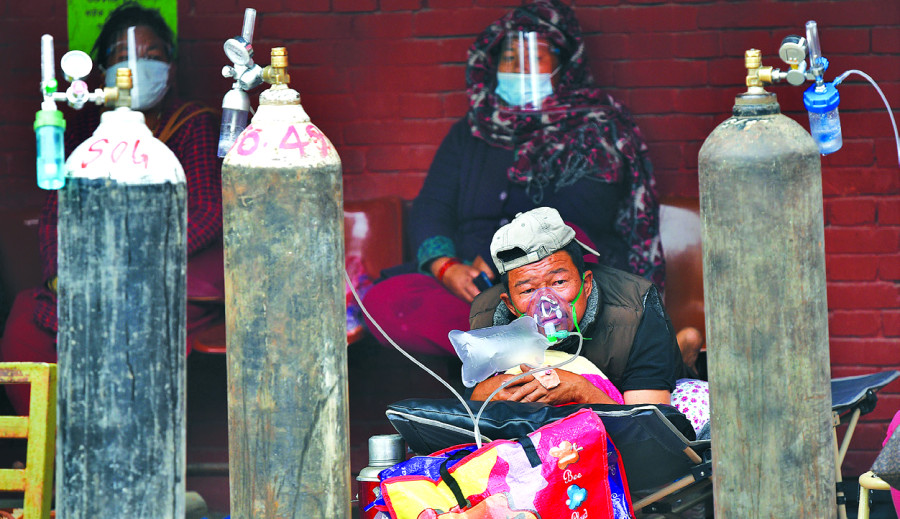Health
Dhulikhel Hospital under strain as virus cases spike in villages
The hospital is dealing with more Covid-19 patients from nearby districts lately, as experts warn of a catastrophe.
Anup Ojha
Shankar Lama’s pregnant daughter returned to her father’s home in Panchpokhari Rural Municipality, Sindhupalchok the day before prohibitory orders were enforced in the Kathmandu Valley on April 29.
But days later she had a dry cough, fever, and breathing difficulties—all symptoms of Covid-19. Lama rushed her to the nearby health post. Health workers there advised him to take her to Dhulikhel Hospital in Kavre as she was also pregnant.
Pregnant women have lower immunity and if infected they are more at risk, according to doctors and international studies.
At the hospital, she tested positive for the coronavirus.
She was admitted to the intensive care unit at Dhulikhel Hospital where she spent a week.
“Now her condition is much better and her test result has also come negative,” the 61-year-old father told the Post over the phone Thursday afternoon. “Maybe she will get discharged this evening.”
But his worries are not over yet. His wife, son and daughter-in-law also live with him.
“Till now nothing has happened to us but I am really scared about what if the virus has transmitted to other family members,” said Lama.
Two days before the prohibitory orders came into effect, a lot of people working and studying in Kathmandu left for their villages. Many people working and studying in the Capital also returned to Lama’s village.
“There are many villagers who have similar symptoms as my daughter but they do not go for a check-up until they get severely sick,” said Lama.
Besides Kavre, Covid-19 patients from nearby districts like Sindhupalchok, Ramechhap, Dolakha, Sindhuli and even as far as Mahottari also come to the hospital for treatment, according to Biraj Karmacharya, chief of the Department of Community Programs at Dhulikhel Hospital, a Kathmandu University Hospital.
Ramesh Shrestha brought his sister-in-law from Bhimeshwar Municipality in Dolakha and she spent 15 days at the hospital. She was discharged on Wednesday.
“Luckily, we saved her,” said Shrestha. “She would not have survived if we had not taken her there.”
She was taken to the hospital after she had breathing difficulties and was given oxygen therapy at the intensive care unit.
Her husband and their two sons did not test positive.
But in their village, there are people who are ill.
Dr Sher Bahadur Pun, chief of the Clinical Research Unit at the Sukraraj Tropical and Infectious Disease Hospital, is not surprised about the growing number of cases in villages across the country.
“The number of cases will gradually increase in villages,” Pun told the Post.
On April 14, when the second wave of the pandemic was entering the country and there were more than 500 cases nationwide for the first time since early January, there were zero cases in Kavre, where Dhulikhel Hospital is situated, zero in Dolakha and just two in Sindhupalchok.
On Tuesday, Kavre recorded 315, Dolakha 90, and Sindhupalchok 105. On Thursday, the three districts saw 125, 67 and nine cases respectively.
Nationwide, 8,227 new infections were reported on Thursday taking the total tally to 488,645 of which 115,852 cases are active.
The Ministry of Health and Population reported 190 more deaths in the last 24 hours taking the total toll to 5,847.
But according to Dr Pun, the recorded cases so far do not reflect the actual number of cases in Nepal.
“In many villages PCR tests or antigen tests are not possible and this creates the problem of finding the real data on the number of people who are infected,” said Pun.
At Dhulikhel Hospital, the number of people coming with severe cases of Covid-19 has gone up significantly over the last two weeks and they are from the villages.
“Earlier, we used to get Covid-19 patients mainly from Kathmandu and Bhaktapur after beds in hospitals there were filled, but now more cases are coming from remote villages,” said Karmacharya. “We rarely get cases from the Valley.”
In the Valley, hospitals report that the rush of new patients is not as bad as it was about two weeks earlier.
“Throughout Thursday, I rarely noticed ambulances coming to the hospital with patients,” said Pun. “Two weeks ago there was a new patient coming every 10 minutes.”
Patients had to be treated on floors and in the courtyard.
According to Dr Sagar Kumar Rajbhandari, director at Sukraraj Tropical and Infectious Disease Hospital, five beds in the emergency ward were unoccupied on Thursday evening.
“Now the flow of patients is normal and people do not have to stay in line for oxygen,” said Rajbhandari. “There are a few patients in the corridors but they are in beds and they are only moderately ill.”
But at the Dhulikhel Hospital of the total 500 beds, 135 are occupied by Covid-19 patients. The hospital, through its 18 rural outreach centres, also operates additional 200 beds for Covid patients.
“Every day the hospital gets an average of 15 new patients. They all need oxygen therapy,” said Dr Rajendra Koju, dean of the medical college.
Some of them do not even make it to the hospital as they come there at the last moment.
On Wednesday night, a 35-year-old man from Jaleshwar Municipality, Mahottari died while he was being brought to the hospital.
Pun said he has now started getting calls from people in Humla and Jumla and other remote parts complaining that they have Covid-19 symptoms.
“Now the virus has reached rural parts of the country, and I am really worried people there are not vaccinated, they don’t have access to good hospitals and oxygen, so if the state does not work to ensure oxygen supply, in remote parts more people will die on their way to the health facilities,” said Pun.
Apart from the mass exodus of people who left the Kathmandu Valley before the authorities enforced prohibitory orders, according to Karmacharya, people’s participation in mass gathering in social functions like wedding and other life rituals like bratabandha and people’s unfounded belief that the virus would not affect people in villages where there is fresh air, has created this problem.
“But the virus has reached remote villages,” said Karmacharya. “For most people who come to our hospital it is their last resort.”
The prognosis seems dire.
“There is going to be a catastrophe as health facilities in the rural areas do not even have oximeters to measure the oxygen level,” said Pun. “The central and federal government should be aware of this fact and work together with local governments without any delay.”




 8.12°C Kathmandu
8.12°C Kathmandu.jpg)














